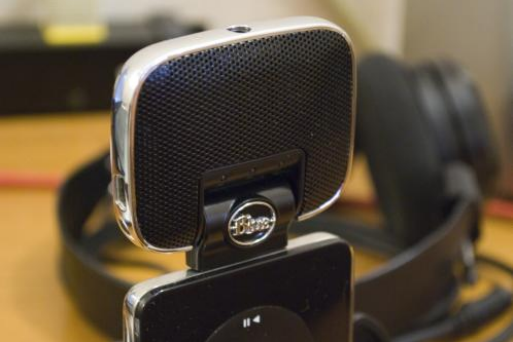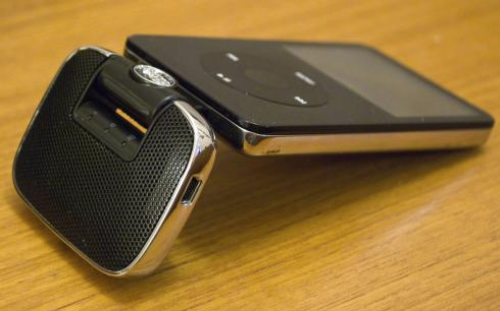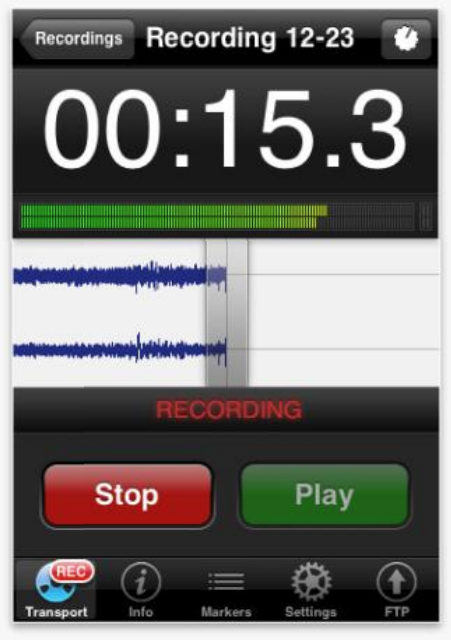Mikey 2.0 from Blue Microphones A Studio Microphone – To Go!

[June 2011] Although most every cell phone can record audio, would you really want to use it on the air? Scott Johnson found a microphone that might be the answer for iPhone and iPod users.
If you work in broadcasting, sooner or later you are going to run into a situation where you want to record some audio – easily, cleanly … and right now.
Ready When You Need It
For most of us, that has meant having some form of digital or analog recorder that we carry around, waiting for the day we are going to need it. We know that on Complacency Day, the one day we decide to leave it at the office or at home – that is the day we will need it.
In many ways, audio recorders are just like cameras; famed photographer Chase Jarvis once said that “The best camera is the one that’s with you.” However, my goal is, whenever possible, to do better than that.
As an audio guy, I am never far from my iPod or iPhone. Keeping all my favorite music at my fingertips is a luxury my father could never have imagined in his time, and I love it. Since I am carrying a sophisticated digital audio device around with me all the time, a great microphone is all that really stands between me and highquality audio recording on the go.
A Look at the Mikey
Mikey, an accessory from Blue Microphones, brings that high level of quality, along with convenience and availability to my audio recording.

All you need to do is plug it into a compatible iPhone or iPod and you have both a studio- 2 quality, stereo microphone and a broadcast-quality digital recorder right in the palm of your hand.
The Mikey connects to the 30-pin Apple dock connector of your device and contains two high-quality microphone elements arranged in a near coincident configuration with a built-in preamp. The microphone head is hinged and can swing 230 degrees to accommodate different recording needs.
The front, or recording, side of the microphone has the company’s logo and three small blue LEDs which indicate the setting of the sensitivity switch. On the back, which has the word “MIKEY,” a three-position switch selects one of three sensitivity ranges to accommodate anything from a whisper to a full-on rock concert.
On the top is a 3.5” stereo mini-jack set up to accept line level signals to be recorded in lieu of the microphone. Finally, on the left side (as seen from the front), a mini-USB jack allows power to be passed to the iPod or iPhone so that you can recharge the Mikey even while using it.
Improved Version
The currently available Mikey is called Mikey 2.0, because it replaces an earlier version of the device. As the former owner of one of these, I can tell you that the new Mikey is a huge improvement!
On the older device, the dock connector was very loose; even a careless bump during a recording would often knock it loose and end the recording instantly. The new Mikey’s connector is smooth and secure, and I feel confident it is not about to fall out.
The movable microphone head is especially useful. Extend it straight out from the bottom of the iPhone or iPad for recording your own voice. Flip it down and set the iPod down, and it acts as both microphone and stand.

Flip it up and lay the iPod flat on a table for a hands-free, voice-over mode. The Mikey handles a wide range of audio
What really matters, of course, is the sound, and it is quite good. I made several test recordings in different situations – live music, an office meeting, some voice-over for a podcast, and a bit of outdoor ambiance. In every case, the clarity and crispness of the Mikey exceeded my expectations.
About the only complaint I could strain to make was that at high sensitivities, there was a bit of noise which sounded like interference from the iPod’s own electronics – and this may be a fact of life when a microphone is that close to what is essentially a small computer.
Simple Operation
On an iPod, such as the iPod 5G that I used in my testing, Mikey automatically activates the “Voice Memos” feature as soon as it is plugged in.
Recording is simple and straightforward. Then just plug the iPod back into your computer (with Disk Mode enabled) and browse to the “Recordings” folder to find your files, which are helpfully named by date and time.
On an iPod touch or iPhone (3gs or older), you will want the Blue FiRe app, available free on the App Store. With Blue FiRe you will have a level meter, a truly variable input gain control, timed recording options, and the ability to ftp your recordings to a server of your choice.

FiRe is quite a nice little recording app, and does as much as many paid tools do. (Psst – it will also record audio from your iPhone’s internal microphone when Mikey is not plugged in – even on the iPhone 4!)
Of course, as a free app, it does nag you occasionally to upgrade to the full app, “FiRe 2,” which has a myriad of additional features and sells for a mere $5.99. Sophisticated tools like editable markers make this a tool for the true audio geek. (Search for “Audiofile Engineering” on the App Store to find FiRe 2, or follow the link from within BlueFire.)
A Compatibility Issue
The news is not all good, unfortunately. While the Mikey 2.0 works with most older iPods, iPod touches, and iPhones, it will not work at all with any current-generation Apple product – meaning that you cannot use it with the latest iPod touch, the iPad, or (to my personal dismay) the iPhone 4.
The reason for this was surprising. Although the 30-pin dock connector has analog input pins, Apple chose to drop support for them in all their new products. Any device that needs to send audio to these newer devices will have to send it digitally, and will therefore need its own A/D converters.
I contacted Apple’s PR department and asked them when they had notified accessory manufacturers about this. The PR representative specifically declined to provide any information about that matter, although she did state that the official release date of the iPhone 4 was in June 2010, a full year ago.
It does seem as that even if Blue had learned of the change when they saw their first iPhone 4, there has been enough time for a redesign but, as Blue points out, over 200 million Apple devices have been sold worldwide that are still compatible with Mikey. Blue’s web site indicates that they are working on a new, iPhone 4- compatible model and hope to have it ready this year.
Compact Size
Mikey comes packaged with its own cloth carrying bag. The owner’s manual is compact enough to also fit into that little bag, which is a nice convenience. It is a surprisingly compact device (2.5 inches square and .5 inch thick).
The Mikey lists at a mere $99.99 – and has been seen priced much lower than that from online retailers. For further information, check the Blue Microphones web site: http://www.bluemic.com/mikey/
– – –
Scott Johnson is a Systems Engineer for a major broadcast equipment manufacture. His email is: scott@ks3j.net
– – –
Are articles like this helpful to you? If so, you are invited to sign up for the one-time-a-week.BDR Newsletter.
It takes only 30 seconds by clicking here.
– – –
